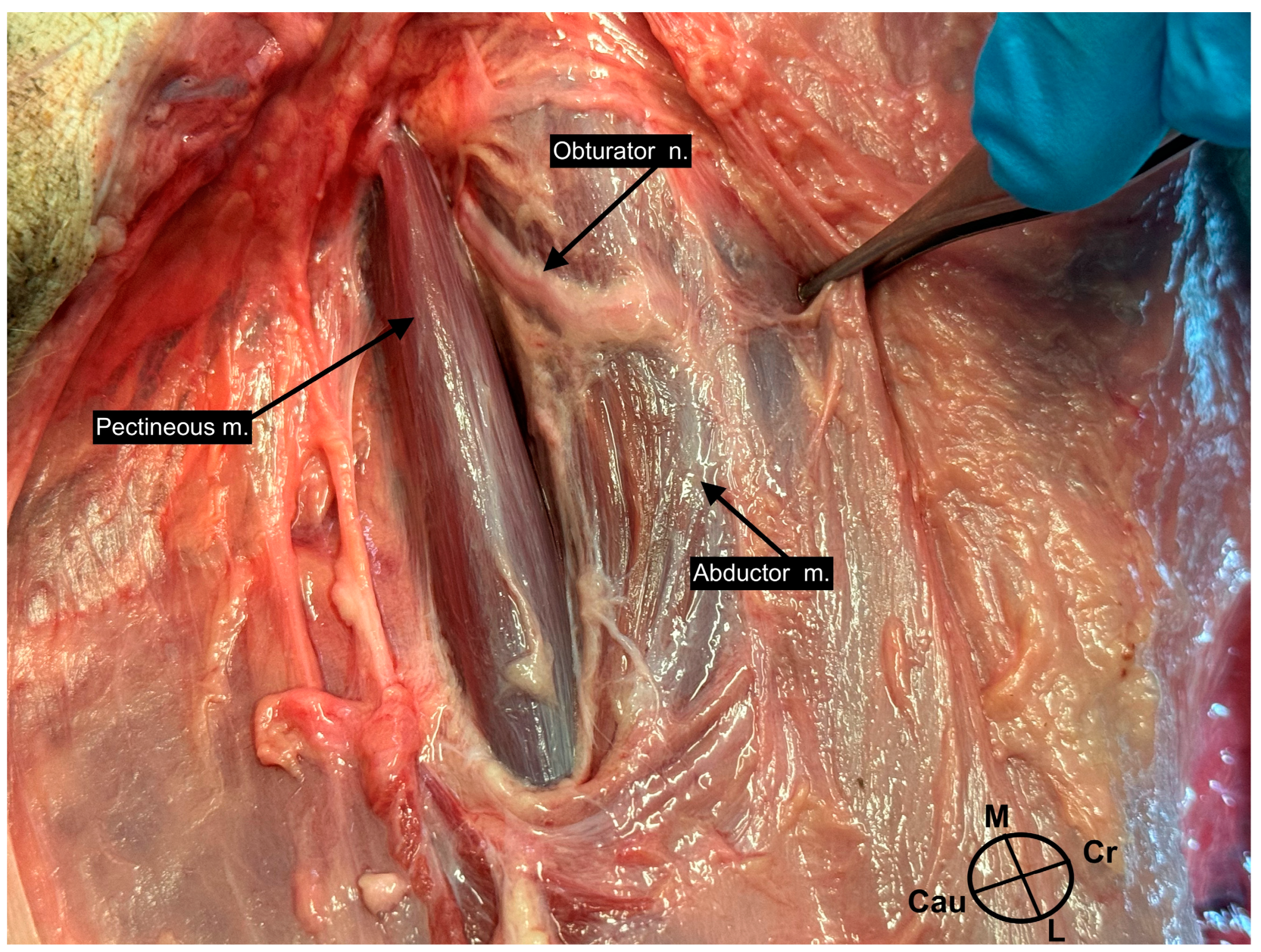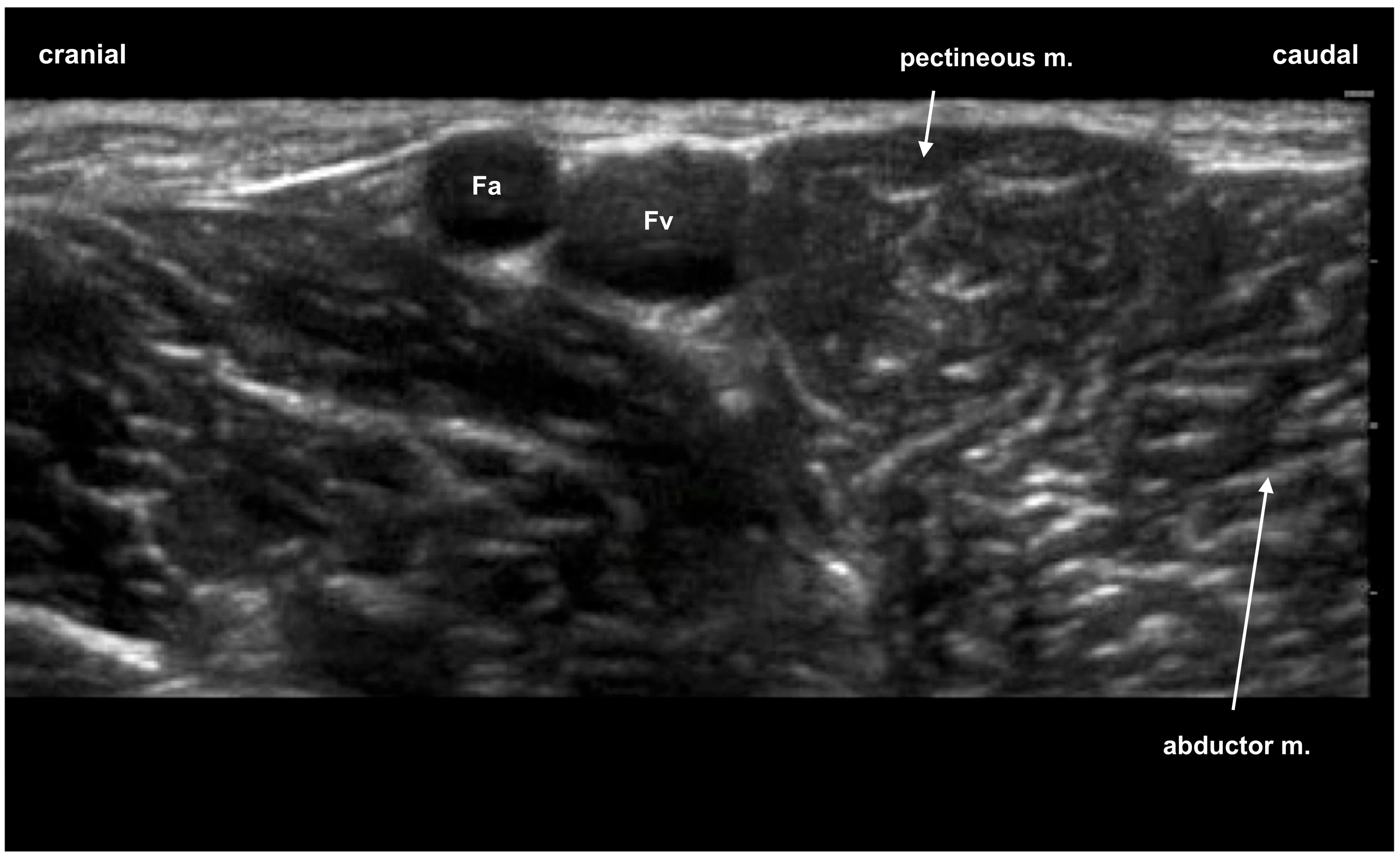Saphenous and Sciatic Nerve Blockade with and without Obturator Nerve Block for Tibial Plateau Levelling Osteotomy Surgery in Dogs: A Randomized Controlled Trial
Abstract
:Simple Summary
Abstract
1. Introduction
2. Materials and Methods
2.1. Phase 1: Anatomical Study
2.2. Phase 2: Clinical Study
2.3. Statistical Analysis
3. Results
3.1. Phase 1
3.2. Phase 2
4. Discussion
5. Conclusions
Supplementary Materials
Author Contributions
Funding
Institutional Review Board Statement
Informed Consent Statement
Data Availability Statement
Conflicts of Interest
References
- Spinella, G.; Arcamone, G.; Valentini, S. Cranial Cruciate Ligament Rupture in Dogs: Review on Biomechanics, Etiopathogenetic Factors and Rehabilitation. Vet. Sci. 2021, 8, 186. [Google Scholar] [CrossRef] [PubMed]
- Beer, P.; Bockstahler, B.; Schnabl-Feichter, E. Tibial plateau leveling osteotomy and tibial tuberosity advancement—A systematic review. Tierarztl. Prax. Ausg. K Kleintiere Heimtiere 2018, 46, 223–235. [Google Scholar] [CrossRef] [PubMed]
- Slocum, B.; Slocum, T.D. Tibial plateau leveling osteotomy for repair of cranial cruciate ligament rupture in the canine. Vet. Clin. N. Am. Small Anim. Pract. 1993, 23, 777–795. [Google Scholar] [CrossRef] [PubMed]
- Boscan, P.; Wennogle, S. Evaluating Femoral-Sciatic Nerve Blocks, Epidural Analgesia, and No Use of Regional Analgesia in Dogs Undergoing Tibia-Plateau-Leveling-Osteotomy. J. Am. Anim. Hosp. Assoc. 2016, 52, 102–108. [Google Scholar] [CrossRef] [PubMed]
- Romano, M.; Portela, D.A.; Breghi, G.; Otero, P.E. Stress-related biomarkers in dogs administered regional anaesthesia or fentanyl for analgesia during stifle surgery. Vet. Anaesth. Analg. 2016, 43, 44–54. [Google Scholar] [CrossRef]
- Parker, L.A.; Bukoski, A.D.; Zelaya-Nunez, C.; Dodam, J.R.; Varner, K.M.; Torres, B.T. Pelvic limb anesthesia and analgesia in dogs undergoing tibial plateau leveling osteotomy (TPLO): A survey of board-certified anesthesiologists. Vet. Surg. 2023, 52, 521–530. [Google Scholar] [CrossRef]
- Campoy, L.; Martin-Flores, M.; Ludders, J.W.; Erb, H.N.; Gleed, R.D. Comparison of bupivacaine femoral and sciatic nerve block versus bupivacaine and morphine epidural for stifle surgery in dogs. Vet. Anaesth. Analg. 2012, 39, 91–98. [Google Scholar] [CrossRef]
- Echeverry, D.F.; Laredo, F.G.; Gil, F.; Belda, E.; Soler, M.; Agut, A. Ventral ultrasound-guided suprainguinal approach to block the femoral nerve in the dog. Vet. J. 2012, 192, 333–337. [Google Scholar] [CrossRef]
- Portela, D.A.; Otero, P.E.; Briganti, A.; Romano, M.; Corletto, F.; Breghi, G. Femoral nerve block: A novel psoas compartment lateral pre-iliac approach in dogs. Vet. Anaesth. Analg. 2013, 40, 194–204. [Google Scholar] [CrossRef]
- Graff, S.M.; Wilson, D.V.; Guiot, L.P.; Nelson, N.C. Comparison of three ultrasound guided approaches to the lumbar plexus in dogs: A cadaveric study. Vet. Anaesth. Analg. 2015, 42, 394–404. [Google Scholar] [CrossRef]
- Tayari, H.; Tazioli, G.; Breghi, G.; Briganti, A. Ultrasound-guided femoral and obturator nerves block in the psoas compartment in dogs: Anatomical and randomized clinical study. Vet. Anaesth. Analg. 2017, 44, 1216–1226. [Google Scholar] [CrossRef] [PubMed]
- Castro, D.S.; Garcia-Pereira, F.; Giglio, R.F. Evaluation of the potential efficacy of an ultrasound-guided adductor canal block technique in dog cadavers. Vet. Anaesth. Analg. 2018, 45, 566–574. [Google Scholar] [CrossRef] [PubMed]
- Marolf, V.; Rohrbach, H.; Bolen, G.; Van Wijnsberghe, A.S.; Sandersen, C. Sciatic nerve block in dogs: Description and evaluation of a modified ultrasound-guided parasacral approach. Vet. Anaesth. Analg. 2019, 46, 106–115. [Google Scholar] [CrossRef]
- Ferrero, C.; Borland, K.; Rioja, E. Retrospective comparison of three locoregional techniques for pelvic limb surgery in dogs. Vet. Anaesth. Analg. 2021, 48, 554–562. [Google Scholar] [CrossRef] [PubMed]
- Bini, G.; Vettorato, E.; De Gennaro, C.; Corletto, F. A retrospective comparison of two analgesic strategies after uncomplicated tibial plateau levelling osteotomy in dogs. Vet. Anaesth. Analg. 2018, 45, 557–565. [Google Scholar] [CrossRef] [PubMed]
- Warrit, K.; Griffenhagen, G.; Goh, C.; Boscan, P. Comparison of ultrasound-guided lumbar plexus and sciatic nerve blocks with ropivacaine and sham blocks with saline on perianesthetic analgesia and recovery in dogs undergoing tibial plateau leveling osteotomy surgery. Vet. Anaesth. Analg. 2019, 46, 673–681. [Google Scholar] [CrossRef] [PubMed]
- Warrit, K.; Griffenhagen, G.; Goh, C.; Boscan, P. Financial impact of ultrasound-guided lumbar plexus and sciatic nerve blocks with electrostimulation for tibial plateau leveling osteotomy surgery in dogs. Vet. Anaesth. Analg. 2019, 46, 682–688. [Google Scholar] [CrossRef] [PubMed]
- Palomba, N.; Vettorato, E.; De Gennaro, C.; Corletto, F. Peripheral nerve block versus systemic analgesia in dogs undergoing tibial plateau levelling osteotomy: Analgesic efficacy and pharmacoeconomics comparison. Vet. Anaesth. Analg. 2020, 47, 119–128. [Google Scholar] [CrossRef]
- O’Connor, B.L.; Kunz, B.; Peterson, R.G. The composition of the medial articular nerve to the knee in the dog. J. Anat. 1982, 135 Pt 1, 139–145. [Google Scholar]
- Papadopoulos, G.; Duckwitz, V.; Doherr, M.G. Femoral and sciatic nerve blockade of the pelvic limb with and without obturator nerve block for tibial plateau levelling osteotomy surgery in dogs. Vet. Anaesth. Analg. 2022, 49, 407–416. [Google Scholar] [CrossRef]
- Di Franco, C.; Tayari, H.; Nardi, S.; Briganti, A. Along or across the visual axis: A comparison of two ultrasound screen, needle and transducer orientation techniques. Vet. Anaesth. Analg. 2021, 48, 147–150. [Google Scholar] [CrossRef] [PubMed]
- Echeverry, D.F.; Gil, F.; Laredo, F.; Ayala, M.D.; Belda, E.; Soler, M.; Agut, A. Ultrasound-guided block of the sciatic and femoral nerves in dogs: A descriptive study. Vet. J. 2010, 186, 210–215. [Google Scholar] [CrossRef] [PubMed]
- Shilo, Y.; Pascoe, P.J.; Cissell, D.; Johnson, E.G.; Kass, P.H.; Wisner, E.R. Ultrasound-guided nerve blocks of the pelvic limb in dogs. Vet. Anaesth. Analg. 2010, 37, 460–470. [Google Scholar] [CrossRef] [PubMed]
- Wenger, S.; Moens, Y.; Jäggin, N.; Schatzmann, U. Evaluation of the analgesic effect of lidocaine and bupivacaine used to provide a brachial plexus block for forelimb surgery in 10 dogs. Vet. Rec. 2005, 156, 639–642. [Google Scholar] [CrossRef] [PubMed]
- Vettorato, E.; De Gennaro, C.; Okushima, S.; Corletto, F. Retrospective comparison of two peripheral lumbosacral plexus blocks in dogs undergoing pelvic limb orthopaedic surgery. J. Small Anim. Pract. 2013, 54, 630–637. [Google Scholar] [CrossRef]
- Reid, J.; Nolan, A.M.; Hughes, J.M.L.; Lascelles, D.; Pawson, P.; Scott, E. Development of the short-form Glasgow Composite Measure Pain Scale (CMPS-SF) and derivation of an analgesic intervention score. Anim. Welf. 2007, 16, 97–104. [Google Scholar] [CrossRef]
- Otero, P.E.; Portela, D.A. (Eds.) Obturator nerve block. In Manual of Small Animal Regional Anesthesia: Illustrated Anatomy for Nerve Stimulation and Ultrasound-Guided Nerve Blocks, 2nd ed.; Editorial Inter-Medica: Ciudad Autonoma de Buenos Aires, Argentina, 2019; pp. 204–208. [Google Scholar]
- Caniglia, A.M.; Driessen, B.; Puerto, D.A.; Bretz, B.; Boston, R.C.; Larenza, M.P. Intraoperative antinociception and postoperative analgesia following epidural anesthesia versus femoral and sciatic nerve blockade in dogs undergoing stifle joint surgery. J. Am. Vet. Med. Assoc. 2012, 241, 1605–1612. [Google Scholar] [CrossRef]
- Marolf, V.; Spadavecchia, C.; Müller, N.; Sandersen, C.; Rohrbach, H. Opioid requirements after locoregional anaesthesia in dogs undergoing tibial plateau levelling osteotomy: A pilot study. Vet. Anaesth. Analg. 2021, 48, 398–406. [Google Scholar] [CrossRef]
- Huang, C.H.; Hou, S.M.; Yeh, L.S. The innervation of canine hip joint capsule: An anatomic study. Anat. Histol. Embryol. 2013, 42, 425–431. [Google Scholar] [CrossRef]
- Kalamaras, A.B.; Aarnes, T.K.; Moore, S.A.; Jones, S.C.; Pereira, C.R.; Peng, J.; Kieves, N.R. Effects of perioperative saphenous and sciatic nerve blocks, lumbosacral epidural or morphine-lidocaine-ketamine infusion on postoperative pain and sedation in dogs undergoing tibial plateau leveling osteotomy. Vet. Anaesth. Analg. 2021, 48, 415–421. [Google Scholar] [CrossRef] [PubMed]
- Congdon, J.M.; Boscan, P.; Goh, C.S.S.; Rezende, M. Psoas compartment and sacral plexus block via electrostimulation for pelvic limb amputation in dogs. Vet. Anaesth. Analg. 2017, 44, 915–924. [Google Scholar] [CrossRef]






| Time | Procedure |
|---|---|
| T0 | five minutes before preparation of the operative field |
| T1 | during the preparation of the surgical field |
| T2 | incision skin and subcutaneous tissue |
| T3 | incision joint capsule |
| T4 | distraction of the knee joint |
| T5 | meniscectomy |
| T6 | suture joint capsule |
| T7 | periosteal incision |
| T8 | positioning external fixator |
| T9 | osteotomy |
| T10 | positioning plate osteosynthesis |
| T11 | suture muscle planes |
| T12 | suturing skin and subcutaneous tissue |
| ON Group | NoON Group | |
|---|---|---|
| Duration of anaesthesia (minutes) | 140 ± 20 | 125 ± 18 |
| Duration of surgery (minutes) | 62 ± 12 | 61 ±13 |
| Weight (kg) | 27 ± 10 | 28 ±11 |
| Age (years) | 6.8 ± 3.4 | 7 ± 3.2 |
| Time | ON Group | NoON Group |
|---|---|---|
| T0 | 0/15 | 0/15 |
| T1 | 0/15 | 0/15 |
| T2 | 0/15 | 0/15 |
| T3 | 0/15 | 12/15 |
| T4 | 2/15 | 0/15 |
| T5 | 0/15 | 0/15 |
| T6 | 0/15 | 0/15 |
| T7 | 0/15 | 0/15 |
| T8 | 0/15 | 0/15 |
| T9 | 2/15 | 3/15 |
| T10 | 0/15 | 0/15 |
| T11 | 0/15 | 0/15 |
| T12 | 0/15 | 0/15 |
Disclaimer/Publisher’s Note: The statements, opinions and data contained in all publications are solely those of the individual author(s) and contributor(s) and not of MDPI and/or the editor(s). MDPI and/or the editor(s) disclaim responsibility for any injury to people or property resulting from any ideas, methods, instructions or products referred to in the content. |
© 2023 by the authors. Licensee MDPI, Basel, Switzerland. This article is an open access article distributed under the terms and conditions of the Creative Commons Attribution (CC BY) license (https://creativecommons.org/licenses/by/4.0/).
Share and Cite
Di Franco, C.; Cipollini, C.; Figà Talamanca, G.; Tazioli, G.; Patroncini, S.; Calistri, M.; Briganti, A. Saphenous and Sciatic Nerve Blockade with and without Obturator Nerve Block for Tibial Plateau Levelling Osteotomy Surgery in Dogs: A Randomized Controlled Trial. Animals 2023, 13, 3792. https://doi.org/10.3390/ani13243792
Di Franco C, Cipollini C, Figà Talamanca G, Tazioli G, Patroncini S, Calistri M, Briganti A. Saphenous and Sciatic Nerve Blockade with and without Obturator Nerve Block for Tibial Plateau Levelling Osteotomy Surgery in Dogs: A Randomized Controlled Trial. Animals. 2023; 13(24):3792. https://doi.org/10.3390/ani13243792
Chicago/Turabian StyleDi Franco, Chiara, Chiara Cipollini, Giacomo Figà Talamanca, Giulio Tazioli, Stefano Patroncini, Maurizio Calistri, and Angela Briganti. 2023. "Saphenous and Sciatic Nerve Blockade with and without Obturator Nerve Block for Tibial Plateau Levelling Osteotomy Surgery in Dogs: A Randomized Controlled Trial" Animals 13, no. 24: 3792. https://doi.org/10.3390/ani13243792






